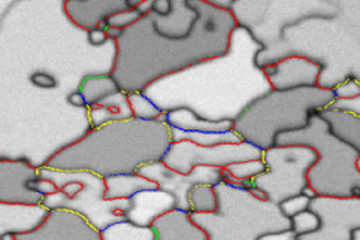All genres
201.
Talk
Detection of Elementary Events in the Depassivation of Nitinol under Mechanical Influence. Go Okamoto Centennial Meeting, Sapporo, Japan (2005)
202.
Talk
Self organised nanostructures from directionally solidified eutectics. Seminar at the National Institute for Materials Science, Tsukuba, Japan (2005)
203.
Talk
Gold Nanowire Arrays via Directional Solid-state Decomposition. EUROMAT 2005, Prag, Czech Republic (2005)
204.
Talk
Single Events in Tribocorrosion - A Quick Microscopic View. Go Okamoto Centennial Meeting, Sapporo, Japan (2005)
205.
Talk
Gold Nanowire Arrays via Directional Solid-state Decomposition. ISMANAM 2005, Paris, Frankreich (2005)
206.
Talk
Formation of self-organised nanostructures from directionally solidified eutectic alloys. 12th International Symposium on Metastable and nano Materials (ISMANAM), Paris, France (2005)
207.
Talk
Local Measurements of the Semi conducting Properties of alpha-Fe2O3 and Cr2O3 Films by Impedance Measurement using the Scanning Droplet Cell Technique. 9th International Symposium on the Passivity of Metals and Semiconductors, Paris, France (2005)
208.
Talk
Deposition of Noble Metals on Nanopores for the Formation of Nanodisc Electrodes. 207th Meeting of The Electrochemical Society, Québec City, Canada (2005)
209.
Talk
Electrode Arrays of Nanoscopic Single Crystals. 207th Meeting of The Electrochemical Society, Québec City, Canada (2005)
210.
Talk
Preparation of One-Dimensionally Structured Electrode Materials by Directional Solidification. 207th Meeting of The Electrochemical Society, Québec City, Canada (2005)
211.
Talk
On the Electrochemical Behaviour of Single Grains of FeCrAl Ferritic Steels. 207th Meeting of The Electrochemical Society, Québec City, Canada (2005)
212.
Talk
Transient Measurements of Single Particle Impacts on Disk Shaped Microelectrodes for the Investigation of Tribocorrosion. 207th Meeting of The Electrochemical Society, Québec City, Canada (2005)
213.
Talk
Modifikation der Fehlstellenkonzentration in Metall-Isolator-Metall-Kontakten und deren Einfluß auf das elektronische Tunneln. Bunsentagung 2005, Frankfurt, Germany (2005)
214.
Talk
A Combined Analytical and Electrochemical Method to Evaluate the Stability of Thermal Spray Coatings. 81. AGEF Seminar „Tribocorrosion“, Düsseldorf, Germany (2005)
215.
Talk
Detection of repassivation transients from single particle impingement on disc shaped microelectrodes. 81. AGEF Seminar „Tribocorrosion“, Düsseldorf, Germany (2005)
216.
Talk
Transient Aspects of Microscopic Tribocorrosion. 4th Baltic Conference on Electrochemistry, Greifswald, Germany (2005)
217.
Talk
Elektrochemie mit und an Nanoelektrodenarrays. 79. AGEF-Symposium, 25 Jahre Elektrochemie in Düsseldorf, Heinrich-Heine-Universität, Düsseldorf, Germany (2004)
218.
Talk
Directional Solidification as a Novel Route to Nanoelectrode Arrays. 5th International Symposium on Electrochemical Micro & Nanosystem Technologies, Tokyo, Japan (2004)
219.
Talk
Elektrochemie für und an Nanoelektrodenarrays. 79. AGEF Seminar - 25 Jahre Elektrochemie, Düsseldorf, Germany (2004)
220.
Talk
On the corrosion resistance of a new class of FeCrAl light weight ferritic steels. 55th Meeting of the International Society of Electrochemistry, Thessaloniki, Greece (2004)











